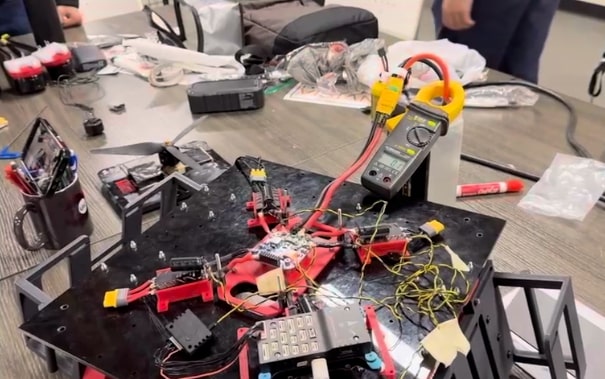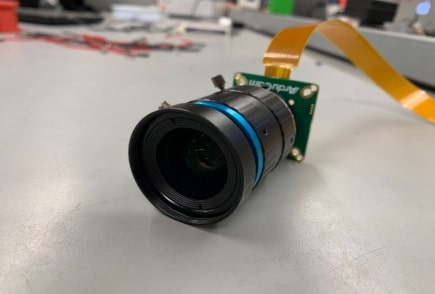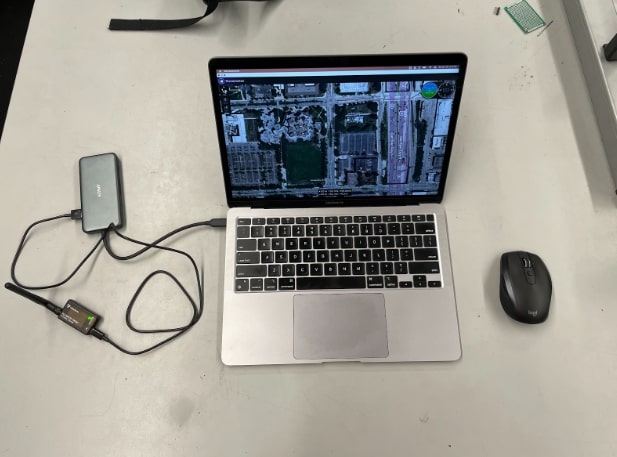Our Subteams
Each subteam consists of members from many different majors who work together to streamline the implementation of various systems into the final product.
Aircraft
The Aircraft Subteam is responsible for designing and constructing a custom-built aircraft engineered for durability, stability, and efficiency. Using a lightweight carbon fiber frame and an aerodynamic design, the team ensures optimal flight performance while accommodating specialized payloads for the C-UASC competition. Their work involves developing the drone's frame and mounting systems using tools like SolidWorks and Ansys, applying principles of statics and dynamics to achieve a structurally sound and efficient design. Parts are produced through in-house 3D printing or outsourced for carbon fiber fabrication. Combined with advanced avionics, precise autonomous control, and robust payload systems, the aircraft is built to excel in complex mission environments while prioritizing safety and reliability.
Payload
The Payload Subteam is responsible for designing and building a reliable and accurate payload delivery system to support mission operations. The team manages every stage of the process, including containment, deployment, and controlled descent, to achieve precise and safe landings on target. Their work involves the design, fabrication, and integration of the full payload system, including any required electronics for deployment. Through careful engineering and rigorous testing, they optimize performance to ensure consistent and efficient operation in challenging competition environments, enabling payloads to be released with precision and land safely.

Avionics
The Avionics Subteam serves as the backbone of the drone's electrical and control infrastructure, enabling seamless integration of all onboard systems. The team is responsible for designing and implementing the drone's entire electrical architecture, including power distribution schematics, custom battery packs that are assembled and spot-welded in-house, and PCBs for low-power regulation and battery management. They integrate critical components such as flight controllers, telemetry radios, GPS/RTK modules, cameras, and motors through custom wiring harnesses and power cables. When off-the-shelf solutions are insufficient, the subteam develops custom hardware to meet mission requirements, ensuring reliable and efficient operation throughout flight.
Vision
The Vision Subteam develops software that enables the aircraft to sense and interpret its environment with precision. This involves detecting ground targets for payload drops and geotagging, generating top-down maps of mission areas similar to Google Maps, and detecting other aircraft to avoid mid-air collisions. The team focuses on real-time object detection using YOLOv5 and 3D mapping with OpenDroneMap, producing data essential for autonomous navigation. Their work centers on writing and testing computer vision algorithms, training object detection models, and processing imagery for navigation, ground mapping, and mission-critical decision-making in coordination with the Guidance, Navigation & Control Subteam.


Guidance Navigation & Control
The Guidance, Navigation, and Control (GNC) Subteam enables fully autonomous flight, ensuring the aircraft can plan and execute missions with precision and reliability. The team develops algorithms for waypoint navigation, dynamic path planning, and real-time flight control, tackling challenges such as navigating to targets and mapping unexplored areas. They leverage processed data from the Vision Subteam—such as detected targets and 3D terrain maps—to enhance autonomous navigation and situational awareness. Mission execution is powered by the ArduPilot flight controller and configured through QGroundControl and Mission Planner. To validate these algorithms, the team conducts extensive software-in-the-loop (SITL) simulations using Gazebo, ensuring robust and reliable autonomous flight.